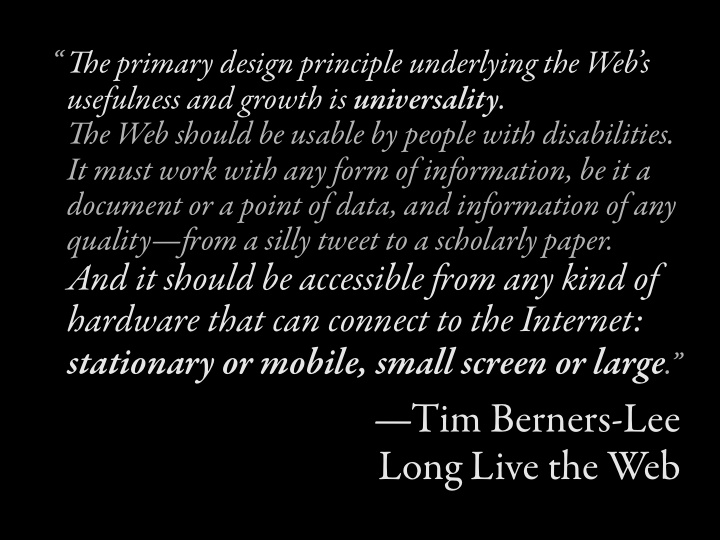



“ T e primary design principle underlying the Web’s usefulness and growth is universality . T e Web should be usable by people with disabilities. It must work with any form of information, be it a document or a point of data, and information of any quality— f om a silly tweet to a scholarly paper. And it should be accessible f om any kind of hardware that can connect to the Internet: stationary or mobile, small screen or large . ” —Tim Berners-Lee Long Live the Web
System + Grid The Page order constraint control
web
web control
+ Table The Layout Browser order constraint control
+ The CSS Browser order constraint control
The Browser unknown
speed capability size unknown
640 x 480 800 x 600 size 1024 x 768 fixed
% flexible
T e control which designers know in the print “ medium, and o f en desire in the web medium, is simply a function of the limitation of the printed page. We should embrace the fact that the web doesn’t have the same constraints, and design for this fl exibility . ” —John Allsopp A Dao of Web Design
WYSIWTF
“ One of the main reasons why many people cling to the expectation that a web design should look the same across every browser is that one of the fi rst things that designers show them is a carefully cra f ed static design made in Photoshop or Fireworks.” —Andy Clarke Time to stop showing clients static design visuals
speed capability size unknown
desktop mobile web tablet
one web flexible
Rather than tailoring disconnected designs to each of “ an ever-increasing number of web devices, we can treat them as facets of the same experience. We can design for an optimal viewing experience, but embed standards-based technologies into our designs to make them not only more fl exible , but more adaptive to the media that renders them.” —Ethan Marcotte Responsive Web Design
clarification
mobile first
content first
behaviour presentation content
<link rel="stylesheet" href="global.css" media="all">
<link rel="stylesheet" href="global.css" media="all"> <link rel="stylesheet" href="layout.css" media="all and (min-width: 30em)">
<link rel="stylesheet" href="global.css" media="all"> <link rel="stylesheet" href="layout.css" media="all and (min-width: 30em)"> <!--[if lt IE 9]> <link rel="stylesheet" href="layout.css" media="all"> <![endif]-->
<link rel="stylesheet" href="global.css" media="all"> <link rel="stylesheet" href="layout.css" media="all and (min-width: 30em)"> <!--[if (lt IE 9) & (!IEMobile)]> <link rel="stylesheet" href="layout.css" media="all"> <![endif]-->
<link rel="stylesheet" href="global.css" media="all"> <link rel="stylesheet" href="layout.css" media="all and (min-width: 30em)"> <!--[if (lt IE 9) & (!IEMobile) & (gt IE 6)]> <link rel="stylesheet" href="layout.css" media="all"> <![endif]-->
<link rel="stylesheet" href="global.css" media="all"> <link rel="stylesheet" href="layout.css" media="all and (min-width: 30em)"> <!--[if (lt IE 9) & (!IEMobile) & (gt IE 6)]> <link rel="stylesheet" href="layout.css" media="all"> <![endif]--> <meta name="viewport" content= "width=device-width">
<link rel="stylesheet" href="global.css" media="all"> <link rel="stylesheet" href="layout.css" media="all and (min-width: 30em)"> <!--[if (lt IE 9) & (!IEMobile) & (gt IE 6)]> <link rel="stylesheet" href="layout.css" media="all"> <![endif]--> <meta name="viewport" content= "width=device-width, initial-scale=1.0">
[role="main"] { ! width: 61.8034%; ! float: left; } [role="complementary"] { ! width: 38.1966%; ! float: right; } @media all and (max-width: 60em) { ! [role="main"], ! [role="complementary"] { ! ! width: 50%; ! } }
if ($(document).width() > 640) { ! $.get('path/to/html', function(data) { ! ! $('[role="complementary"]').append(data); ! }); }
“ It’s my belief that in order to embrace designing native layouts for the web – whatever the device – we need to shed the notion that we create layouts f om a can v as in. We need to fl ip it on its head, and create layouts f om the content out .” —Mark Boulton A Richer Canvas
web apps?
it depends
context first?
Mind reading is no way to base “ fundamental content decisions.” —Mark Kirby T e Mobile context
My lo v e for responsive centers around the idea that “ my website will meet you wherever you are — f om mobile to full-blown desktop and anywhere in between.” —Trent Walton Fit To Scale
one web
Recommend
More recommend